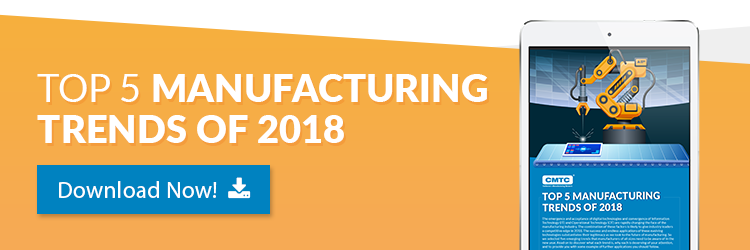March 2, 2018 | Advanced Manufacturing, Manufacturing Technology, Employee Training, Business Growth Strategy & Strategic Planning
Tax Reform Has Manufacturers Investing in Their Future
 In an increasingly competitive marketplace, most manufacturers understand the importance of investing in their business. But, investing means spending money, something many manufacturers can be hesitant to do. This is a dangerous trap to fall into, however, as the long-term benefits of investing can far exceed the short-term hit on the balance sheet.
In an increasingly competitive marketplace, most manufacturers understand the importance of investing in their business. But, investing means spending money, something many manufacturers can be hesitant to do. This is a dangerous trap to fall into, however, as the long-term benefits of investing can far exceed the short-term hit on the balance sheet.
Today, with tax reforms dropping corporate tax rates from 35 percent to 21 percent, there may be even more incentive to invest. And you won’t be alone; a recent NAM survey of over 500 manufacturers reveals that 65 percent feel the tax reform will allow them to increase capital spending.
We’ve identified three main areas small and medium-sized manufacturers may want to consider focusing on if they choose to invest: information systems, equipment, and training.
Investing in Information Systems
If you’re like most manufacturers, you’ve undoubtedly stumbled across issues related to design, procurement, and production. Whether these discoveries were made through hands-on experience, in-depth research, or even just pure luck, the realization of how much they were slowing your workflow processes was a real eye-opener. A state-of-the-art Manufacturing Information System (MIS) can take things a step further, offering complete transparency into the workflow.
With an MIS in place, manufacturers gain a 360-degree view into production on the factory floor, in real time; this gives management the ability to make changes that optimize production and eliminate inefficiencies.
Where could your business benefit the most? There are a variety of MIS systems designed to meet your specific industry needs. Some of the benefits of adopting an MIS system or improving upon your existing one include:
- Overall evaluation of procedures
- Streamlined production
- Waste reduction techniques
- Increased output
- Improved efficiency in set-up times
- Record-keeping transparency
- Audit preparation
- Management of suppliers
- Assignment of staff
- Reassessment of priorities
Investing in Equipment
New technologies can make your operations smarter, faster, and far more cost-effective—which all help to make you more competitive. But how? To best demonstrate the ways an investment in new equipment and technology can pay off, let’s take a look at two Advanced Manufacturing technologies other small and medium-sized manufacturers are beginning to employ and the benefits they present.
- Additive manufacturing
- Enables design modification during production
- Reduces the amount of capital needed to scale up production without making major changes, increasing speed and profitability.
- Reduces energy by using less material and eliminating production steps
- Reduces waste by up to 90 percent
- Robotics and Automation
- Creates efficiencies, improving upon human motions by moving faster and more smoothly
- Improves quality by offering a high degree of accuracy and precision
- Offers continuous, 24/7 production
- Increases workplace safety by performing the more dangerous tasks.
Investing in Training
On one hand, you’ve got Baby Boomers leaving the factory floor—nearly one-quarter of manufacturing employees are age 55 or older—taking with them potentially years of unreclaimable tribal knowledge. On the other hand, you’ve got new equipment and technology coming onto the floor, without properly trained employees to operate them. Both of these scenarios make training critical.
The first step is to assess the current competency level of workers to determine their needs. Leveraging their full potential will help increase their engagement and make them more productive to the business.
The next step is determining what skills will be needed in the near future in order to provide training to newer employees and new hires. After all, while investing in high-tech equipment and advanced technologies is great, you’re also going to need a skilled workforce to operate them—and keep up with newer advancements down the road. Adopting new technologies has another added benefit; it can help attract millenials—and fill some of those hard-to-fill manufacturing positions—by chipping away at the perception of manufacturing as “dark, dirty, and dangerous.”
Making Your Move
Some manufacturers fear the tax cut may cause jobs cuts, as manufacturers invest in equipment, not people. But Rick Schreiber of NAM explains why this should not be a deterrent to investing.
“[Tax reform] is not the gloom and doom of jobs going away,” he told U.S. News and World Report. “It’s getting rid of all those unskilled, carpal-tunnel-inducing, heavy-lifting-type jobs. You can now have a cobot—a robot that collaborates with a human—do all those mundane tasks or all that heavy lifting or reduce workers’ compensation-type claims and costs.”
Investing in information systems, equipment, and training is an investment in the future. And the future is looking bright.

